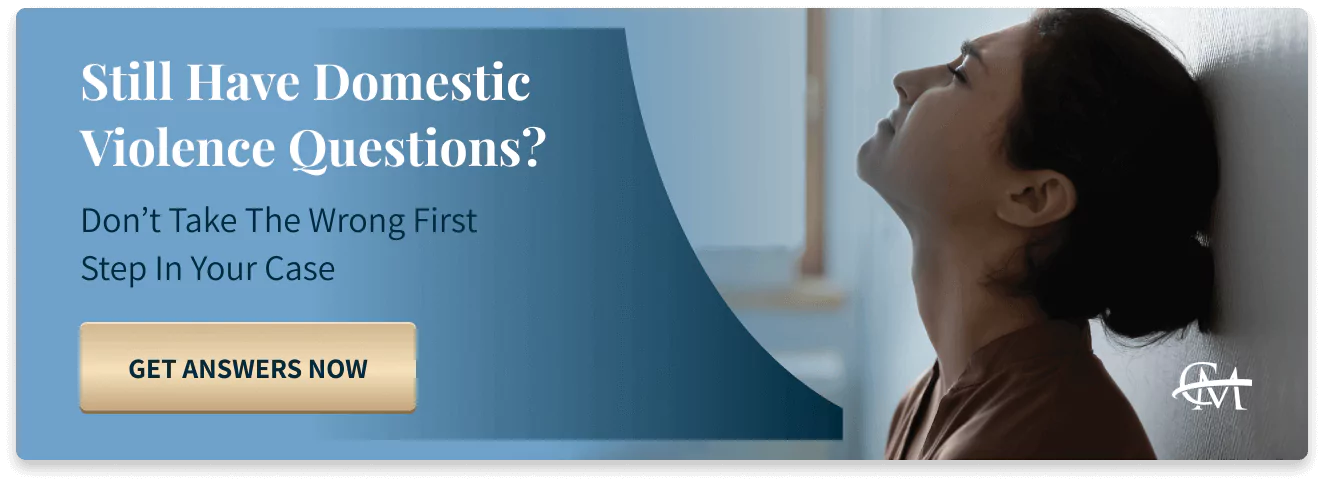- Law Practice Areas
- Resources For You
- Child Support Calculator
- Take Our Divorce Quiz
- Protect Your Assets and Net Worth During Divorce
- Blog
- Family Law Videos
- Your Guide to California Divorce
- Your Guide to Child Custody & Support
- Everything You Need to Know About Getting a Prenup
- An In-Depth Look at Divorce Mediation
- Top Considerations for High Asset Divorce
- Our Legal Team
- Locations
- Reviews
- Contact

While the United States Constitution guarantees its citizens “the right of the people to keep and bear Arms,” there are restrictions on this right.
![shutterstock_552285421.3).1)[1]](https://www.cageandmiles.com/hs-fs/hubfs/Stock%20Photos/shutterstock_552285421.3).1)%5B1%5D.jpg?width=1000&height=662&name=shutterstock_552285421.3).1)%5B1%5D.jpg)
A Brief Overview of Domestic Violence in California
In California, domestic violence — or abuse — is defined in a multitude of ways. The common definitions include when one intentionally or recklessly causes or attempts to cause bodily injury, sexual assault, or imminent serious bodily injury to a spouse or former spouse; cohabitant or former cohabitant in a home; a parent with whom the individual has a child; or a partner in a dating relationship.
It is important to note that abuse is not limited to the actual infliction of physical injury or assault. Stalking, threatening, credibly impersonating, falsely personating, harassing, excessive telephone calls, destroying personal property, and disturbing the peace of another can all be considered forms of abuse that might qualify for a Domestic Violence Temporary Restraining Order as well.
Gun Restrictions Under a Domestic Violence Restraining Order
In California, the Domestic Violence Prevention Act allows a Family Law Court to restrict a party who is restrained under a Domestic Violence Restraining Order (or “DVRO”) from owning a firearm and/or ammunition. The restrained party must immediately dispose of any firearms or ammunition in his or her possession upon being served with a Domestic Violence Temporary Restraining Order (or a “DVTRO”).
This can be accomplished by selling it, destroying it, storing it with a gun dealer or turning it in to a police station. The Court may, as a limited exemption from the relinquishment requirements, allow the restrained party to keep their firearm if it is a necessary condition of continued employment and that employer is unable to reassign the restrained party to another position where the firearm or ammunition is unnecessary.
Gun Restrictions Under Criminal Law
While actions under the Domestic Violence Prevention Act are adjudicated in Family Court — making it a civil action — the same acts of abuse that lead to a DVRO can also lead to criminal actions in criminal court. A conviction of specific kinds of domestic violence under the California Penal Code carries even heavier penalties for gun owners. For example:
- If one is convicted in criminal court for willfully causing or inflicting unjustifiable physical pain or mental suffering on an elder or dependent adult, that person will be restricted from owning, purchasing, receiving, or having in their possession or under custody or control, a firearm for a period of 10 years.
- The punishment for violating the gun ownership restriction after such a conviction is imprisonment for no more than one year, a fine of no more than $1,000, or both.
- The punishment for violating the gun ownership restriction after such a conviction is imprisonment for no more than one year, a fine of no more than $1,000, or both.
- A conviction for willfully causing or inflicting unjustifiable physical pain or mental suffering on a minor child will result in a restriction from owning, purchasing, receiving, or having in their possession or under custody or control, a firearm for a period of 10 years.
- The punishment for violating the gun ownership restriction after such a conviction is imprisonment for no more than one year, a fine of no more than $1,000, or both.
- The punishment for violating the gun ownership restriction after such a conviction is imprisonment for no more than one year, a fine of no more than $1,000, or both.
- A conviction of willful infliction of corporal injury resulting in a traumatic condition upon 1) the offender’s spouse or former spouse, 2) the offender’s cohabitant or former cohabitant, 3) the offender’s fiancé or fiancée, or someone with whom the offender has, or previously had, an engagement or dating relationship, or 4) the mother or father of the offender’s child, will result in a restriction from owning, purchasing, receiving, or possessing or under custody or control, a firearm for life.
- The punishment for violating the gun ownership restriction after such a conviction is imprisonment for no more than one year, a fine of no more than $1,000, or both.
So, domestic violence, should it rise to the level or criminal charges being filed against the offender, may result in far heavier restrictions — and penalties for violating those restrictions — than a more straightforward DVRO. Again, this is because DVROs are addressed in Family Court, meaning the consequences reside within the realm of civil court. However, should the state bring criminal charges against the offender and obtain a conviction against him or her, the above-outlined criminal restrictions and penalties become far heavier and with much greater and long-lasting consequences.

Gun Restrictions Under a Gun Violence Restraining Order
However, DVROs apply to a narrow set of applicants: a spouse or former spouse, a romantic cohabitant or former cohabitant, a person with whom the restrained party has or had a dating or engagement relationship, a person with whom the restrained party has had a child, a child of a party, or any other person related by consanguinity or affinity within the second degree.
But what happens when you are fearful of someone who owns a firearm, but you are not related to them in any of the above-described ways? Or, what happens if you are an immediate family member of the firearm owner, but they have not necessarily abused you in the ways in which the Domestic Violence Prevention Act defines abuse (see above)?
A potential solution here calls for another form of restraint that falls outside of Family Court: a Gun Violence Restraining Order.
A Gun Violence Restraining Order (or “GVRO”) enjoins (or restricts) the subject of the petition (i.e., “the subject”) from having in their custody or control, owning, purchasing, possessing, or receiving a firearm or ammunition.
Who May Petition for a Gun Violence Restraining Order?
You may qualify to apply for a Gun Violence Restraining Order if you are related to the subject of the GVRO in any of the following ways:
- An immediate family member of the subject
- An employer of the subject
- A coworker of the subject
- NOTE: a coworker of the subject must have had “substantial and regular interactions with the subject for at least one year and have obtained the approval of the employer”
- NOTE: a coworker of the subject must have had “substantial and regular interactions with the subject for at least one year and have obtained the approval of the employer”
- An employee or teacher of a secondary or postsecondary school that the subject has attended in the last six months.
- NOTE: the employee or teacher here must have obtained the approval of a school administrator or a school administration staff member with a supervisorial role
- NOTE: the employee or teacher here must have obtained the approval of a school administrator or a school administration staff member with a supervisorial role
- A law enforcement officer
- A roommate of the subject
- NOTE: the roommate here means “a person who regularly resides in the household, or who, within the prior six months, regularly resided in the household, and who has had substantial and regular interactions with the subject for at least one year.
- NOTE: the roommate here means “a person who regularly resides in the household, or who, within the prior six months, regularly resided in the household, and who has had substantial and regular interactions with the subject for at least one year.
- An individual who has a dating relationship with the subject
- An individual who has a child in common with the subject
- NOTE: the coparent here must have had “substantial and regular interactions with the subject for at least one year”
So, while the types of applicants for a DVTRO are typically of the romantic or familial variety, the applicants for a GVRO go far beyond those sorts of ties.
How to Petition for a Gun Violence Restraining Order in California
A GVRO is accomplished through Civil Court, which differs from Family Court. The party petitioning for the GVRO will do so on an ex parte basis. This means the Civil Court may issue the GVRO on an emergency basis and will do so without first having heard from the subject. The petitioning party will fill out a “GV:100—Petition for Gun Violence Restraining Order” and file it in the Civil Court. The petitioning party will provide information about himself or herself, information about the subject, the relationship between the petitioning party and the subject, a description of the firearms in question, and provide the grounds for issuance of a GVRO (detailed below).
The petitioning party will have to file an affidavit made in writing and signed under oath, or the court will take an oral statement from the petitioning party. In the affidavit, the petitioning party must show a substantial likelihood that both of the following are true:
- The subject poses a significant danger, in the near future, of causing personal injury to the subject of the petition or another by having in their custody or control, owning, purchasing, possessing, or receiving a firearm (detailed further below)
- An ex parte GVRO is necessary to prevent personal injury to the subject of the petition or another because less restrictive alternatives either have been tried and found to be ineffective or are inadequate or inappropriate for the circumstances of the subject of the petition.
The same two-pronged analysis will control when the Court determines whether to issue the temporary GVRO on a permanent basis (1-5 years). The party petitioning for the GVRO has the burden of proving both above by a standard of clear and convincing evidence. If the Court finds there is not clear and convincing evidence to issue the permanent GVRO, it will dissolve the temporary GVRO then in effect. If a permanent GVRO is granted, the Court determines the duration of the permanent GVRO by considering the length of time that the circumstances set forth in the above-detailed two-pronged analysis are likely to continue.
How to Show a Subject “Poses a Significant Danger”
The California Penal Code—Section 1855—offers several forms of evidence the Court must consider in determining whether to issue a GVRO:
- A recent threat or act of violence by the subject directed toward another—or toward himself or herself
- NOTE: “recent” means within the six months prior to the date the petition was filed
- NOTE: “recent” means within the six months prior to the date the petition was filed
- A violation of a temporary or permanent Domestic Violence Restraining Order, Civil Harassment Restraining Order, or a restraining order protecting a dependent child of the juvenile court that is in effect at the time the court is considering the petition
- A conviction of certain misdemeanor offenses
- A pattern of violent acts or violent threats within the past 12 months, including but not limited to: threats of violence by the subject directed toward himself, herself, or another.
Now, the Court may also consider other forms of evidence of an increased risk for violence, including the following:
- Unlawful and reckless use, display, or brandishing of a firearm by the subject
- The history of use, attempted use, or threatened use of physical force by the subject against another person
- A prior arrest of the subject for a felony offense
- A history of violations of a temporary or permanent Domestic Violence Restraining Order, Civil Harassment Restraining Order, or a restraining order protecting a dependent child of the juvenile court
-
- NOTE: this differs from “recent” violations, which must occur within six months prior to the date the petition was filed. In other words, the court can also consider violations older than the last six months prior to the date the petition was filed.
- NOTE: this differs from “recent” violations, which must occur within six months prior to the date the petition was filed. In other words, the court can also consider violations older than the last six months prior to the date the petition was filed.
- Documentary evidence of police reports and records of convictions, of either recent criminal offenses by the subject of the petition that involve controlled substances or alcohol or ongoing abuse of controlled substances or alcohol by the subject of the petition
- Evidence of recent acquisition of firearms, ammunition, or other deadly weapons

What Happens If the Court Grants the Petition for a Permanent Gun Violence Restraining Order?
Put simply, if the Court finds there is clear and convincing evidence to issue a permanent GVRO, the court shall issue a GVRO that prohibits the subject from having in the subject’s custody or control, owning, purchasing, possessing, or receiving, or attempting to purchase or receive, a firearm, ammunition, or magazine.
These provisions, commonly referred to as “red flag laws”, are an extremely nuanced and relatively new body of law. They are not to be taken lightly and, as the statutory authority instructs, they can be pursued after less restrictive alternatives either have been tried and found to be ineffective or are inadequate or inappropriate for the circumstances of the subject of the petition. One such “less restrictive alternative” is a DVTRO, as mentioned at the very top of this writing. If you need a DVTRO or have been served with DVTRO, Cage & Miles is here to help. Contact an attorney at Cage & Miles, LLP today to explore your options in this complicated and controversial arena of family law.




